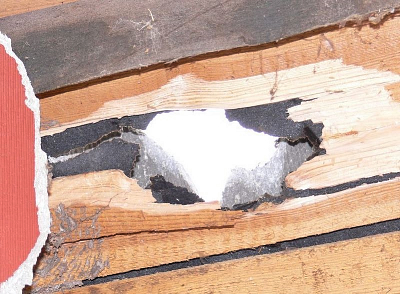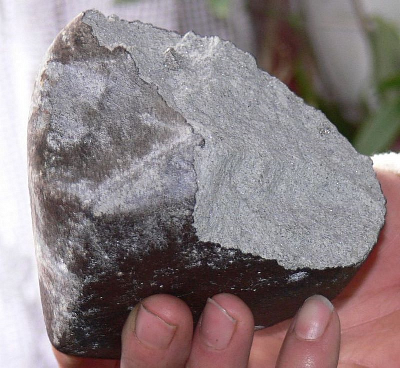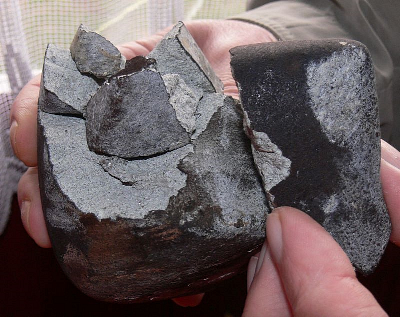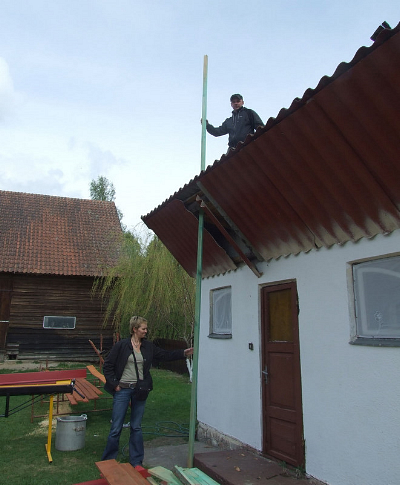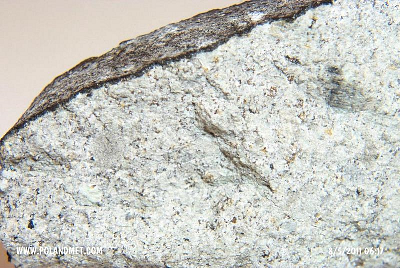IMCA Insights – June 2011
A recent meteorite fall in the village of
Sołtmany, Poland
by Andrzej S. Pilski
In a farm along a picturesque lake in the Mazurkas region of Poland, the owner woke up and opened a window, then suddenly she heard a whistling noise followed by a loud bang and crash as if the house had been crashed into. She ran out to the yard followed by her son. They saw fragments of the roof from a nearby shed hanging over the shed's door and pieces lying on the ground in front of the door. Then they noticed a hole in one of roof boards over the door.
A hole in the roof
(Photo by Roman Rzepka)
Looking around, the farmer spotted a black stone and picked it up. The stone felt slightly warmer than a common stone. She held it for a while, then put it back onto the ground and went back home. She looked at the clock and saw that the local time was 6:06 am; it was the morning of April 30, 2011.
The black, broken
stone
(Photo by Roman Rzepka)
Later her daughter said that it must be a meteorite. They went back to the spot, picked up the stone, took it home and collected other fragments they found in the yard. Then the farmer called a local newspaper in the nearby town of Giżycko. The editor contacted his friend meteorite collector, Mr. Roman Rzepka, who was asked to go to the farm and see if it was really a meteorite. He did so the next day and confirmed the meteoritic origin of the stone. He also took some photos and after returning home he called the author.
Nearly all the
fragments of the stone
(Photo by Roman Rzepka)
Unfortunately I could not leave my work at the Planetarium because of the crowd of visitors during the holidays. I called my friends known to the meteorite community as Wadi and Woreczko and asked for their help. They were visiting their family at the opposite end of Poland, however they decided to risk becoming unpopular with their family and crossed the whole country to go examine the fall. On their way they visited me and I gave them a copy of my book on meteorites signed for the finder. As the book started with the story of the Baszkówka fall, I hoped the finder would learn about the importance of the fall she had witnessed. Later it turned out however she drew a different conclusion than what I had hoped for.
Determining the
direction of the fall
(Photo by Jan Woreczko)
In the
afternoon of May 2 Wadi and Woreczko arrived in the town of Giżycko, met
Mr. Rzepka and then together they visited the farm to gather more
detailed information and get some samples for examination in
laboratories. The owner was not willing to give any piece for scientific
examination. Instead she kindly agreed to sell some fragments at a
relatively low price. In the following days she changed her mind and I
received a rude call from her. She said she was cheated by the people I
recommended, and demanded an additional payment to match her new updated
price, a price that had gone up to about 20 times the original price
during the last few days. That is why I never visited the farm and do
not mention her name here. The detailed report by Wadi and Woreczko (in
Polish) may be seen
here.
The samples were sent to Dr. Tadeusz Przylibski, professor in the
Technical University in Wrocław, Poland, known for his papers on
Baszkówka and Zakłodzie published in M&PS. He asked Marcin Cimała to cut
samples for thin sections and this is why Marcin had the opportunity to
send detailed images of the new fall to the Meteorite mailing list.
A slice of the new
fall - close-up view
(Photo by Marcin Cimała)
Just by looking at the pictures, it should be clear to every experienced collector that this was most probably an L6 chondrite. However a classification by experienced eye method is not accepted by the Nomenclature Committee of the Meteoritical Society. So thin sections were prepared and Dr. Łukasz Karwowski, professor in the University of Silesia, known for having classified the previous Polish meteorite find, Święcany, took the thin sections to a microprobe, and his findings confirmed the experienced eye classification, but it was not all that obvious.
The new fall on a diagram Fa versus Fs
An ordinary chondrite group may be determined with the help of the fayalite (Fa) content in olivine and the ferrosilite (Fs) content in pyroxene; one can see on the diagram to which group an ordinary chondrite belongs. However this recent fall is situated on edge of the L field, close to the LL area. So there remained a possibility that it could belong to the L/LL group just like Holbrook, the cobalt content in the kamacite was measured to resolve that. The content was much lower than in Holbrook, and is typical for L chondrites. So the new fall was submitted to the NomCom of the Meteoritical Society as an L chondrite with the suggested name of Sołtmany like the village where the farm hit by the meteorite is located.
A barred olivine
chondrule - thin section view
(Photo by Łukasz Karwowski)
A petrographic type may be determined after detailed examination of a thin-section under a petrographic microscope. On the photo one can see that a barred olivine chondrule is still visible, but it is hard to determine the boundary between the chondrule and the matrix, as it is diffuse. The boundary is even harder to see on the next photo. This suggests a petrographic type 6, and that is confirmed by the well recrystallized matrix containing relatively large plagioclase grains.
A 2 mm olivine
chondrule seems to be rimmed
(Photo by Łukasz Karwowski)
For a
fresh fall, measuring the short-lived cosmogenic isotopes is one of most
important things to do. To find quickly a good laboratory I asked
Norbert Classen for advice. Norbert directed me to professor Addi
Bischoff, who had examined the recent Jesenice fall in Slovenia, and he
suggested that I asked the Gran Sasso laboratory (Italy), where a piece
of Jesenice had been examined. They kindly agreed and a sizable fragment
of the Sołtmany fall is already there under examination. Results of the
ongoing examinations will be displayed in form of a poster during this
year's meeting of the Meteoritical Society in Greenwich (UK).
If an English speaking person would like to pronounce correctly the name
Sołtmany, which was submitted to the NomCom as the suggested name for
this new meteorite, please try to say "salt" and "money" with no pause
in between. Or just ask Marcin Cimała during the upcoming Ensisheim
Show.
This article has been edited by Anne Black and Norbert Classen
•
IMCA Home Page •
IMCA Code of Ethics •
IMCA Member List
•
Join IMCA •
IMCA Meteorite Info
